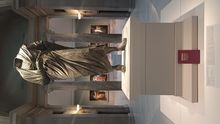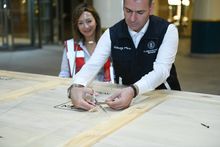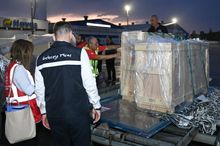 28 Jul 2025
28 Jul 2025
Tags: Turkiye, turkey, Turkish Tourism Board, History, archeology, Marcus Aurelius

As part of its enduring commitment to the sustainability of cultural heritage, Türkiye has achieved another milestone in preservation and repatriation efforts. After 65 years, the bronze statue of Roman Emperor Marcus Aurelius, looted from the ancient city of Boubon in Burdur, has been returned to its homeland in cooperation with U.S. authorities.
The return follows the statue's years-long display at the Cleveland Museum of Art in Ohio. This was made possible thanks to the collaborative efforts of the Turkish Ministry of Culture and Tourism, the Manhattan District Attorney's Office, and U.S. Homeland Security Investigations (HSI).
The Marcus Aurelius statue, dating back to the 2nd and 3rd centuries CE, is a unique piece of ancient art history known for its depiction of the Roman Emperor as a philosopher and considered one of the most exquisite bronze sculptures in Anatolia. The artefact was illicitly excavated and smuggled out of Boubon, located in the Gölhisar district of the southwestern province of Burdur, in the 1960s.
The piece changed hands over the years before being acquired by the Cleveland Museum of Art. The statue has now been repatriated from the USA following a long and determined legal and diplomatic effort and will soon be displayed to the public in an exhibition in the Turkish capital, Ankara on August 6th.
Pioneering Research and Historic Return
The true origin of the Marcus Aurelius statue was first brought to light by Professor Jale İnan, Türkiye's first female archaeologist. Her research helped pave the way for the Turkish Ministry of Culture and Tourism to begin a joint investigation with the Manhattan District Attorney's Office and U.S. Homeland Security Investigations (HSI) in 2021.
The joint effort led to the return of many artefacts of Boubon origin, including statues and busts of Roman emperors Lucius Verus, Septimius Severus, and Caracalla. Years of scientific analysis, archival documents and eyewitness accounts have also revealed that the Marcus Aurelius statue originally belonged to the Sebasteion structure in Boubon.
Based on this scientific evidence, the Manhattan District Attorney's Office and HSI found Türkiye's claim justified and ordered the seizure of the statue from the Cleveland Museum of Art.
A Cultural Victory of Science and Determined Legal and Diplomatic Efforts
Although the Cleveland Museum of Art appealed the seizure order and filed a lawsuit challenging the statue's association with Boubon, Türkiye agreed to scientific analyses to substantiate its claim. For analysis, a silicone cast of the statue's foot was taken under the supervision of Turkish Ministry experts in May 2024. The cast was found to match precisely with the bases found in the ancient city of Boubon.
Soil and lead-carbon samples were collected with extreme care and analysed by Prof. Ernst Pernicka at the Curt Engelhorn Archaeometry Centre laboratories in Germany. The samples definitively confirmed that the statue was indeed once standing in the Sebasteion. Furthermore, a soil sample from the interior of the statue has a similar chemical composition and strontium isotope ratio to three soil samples from Boubon. It also matches a further soil sample from the interior of the “Valerianus” statue in the Burdur Museum, which was reportedly found at Boubon. Following these recent findings, the Cleveland Museum of Art withdrew from the legal proceedings and agreed to the statue's return.
In its official statement, the museum noted: “The museum appreciates the cooperation provided by officials in Türkiye and at the district attorney's office to come to a scientific resolution of the issues surrounding the statue. Without this new research, the museum would not have been able to determine with confidence that the statue was once present at the site.”
This decision reflects a constructive approach that honours both the integrity of museum practices and the rightful return of cultural heritage.
Manhattan District Attorney Alvin Bragg emphasised the value of this international cooperation. He underscored that the investigation involved extensive witness interviews and detailed forensic analysis provided conclusive evidence that the statue had been looted from the ancient city of Boubon. He welcomed the Museum's decision and reaffirmed the importance of returning cultural heritage to its rightful context.
The Minister of Culture and Tourism of the Republic of Türkiye, Mehmet Nuri Ersoy, described this significant restitution as a “historic achievement” in a statement shared on his social media account.
In his message, Minister Ersoy stated that the process, carried out in collaboration with the Manhattan District Attorney's Office and U.S. Homeland Security Investigations, represents more than just the return of a cultural artifact—it stands as a historic success made possible through the combined power of diplomacy, law, and science.
Although the process began with considerable challenges, it is encouraging that it concluded in a constructive manner. This laid the groundwork for future cooperation between the Museum and the Ministry.
This case also sets a valuable precedent for future cooperation between source countries, investigative bodies, and museums. It offers a model for resolving complex provenance issues through transparent and evidence-based dialogue.
Türkiye's Global Vision for Cultural Legacy
The return of the Marcus Aurelius statue to Türkiye is not just a cultural victory but also a shared success of international law, science, and diplomacy. It is also one of the most significant milestones in Türkiye's ongoing fight against the illicit trafficking of antiquities.
The country remains steadfast in its efforts to recover all cultural heritage assets that have been smuggled abroad. These repatriation works are part of Türkiye's broader vision focused on the preservation and sustainable management of its rich cultural heritage. As part of the 'Legacy for the Future Project,' which extends excavations nationwide and throughout all seasons, the country sustains excavation and restoration work in many ancient sites and aims to increase the number of enlightening archaeological works to 800 by 2026.
- Ends -
Notes to Editors
Images
To download images, click here
About Türkiye:
Located in the Mediterranean and connecting Asia and European continents with the famed Bosporus, Türkiye is a unique destination that welcomed more than 62 million international travellers in 2024. The country has always been a hub for cultural interaction and home to varying climates. Today it inspires visitors with its history, nature, and gastronomy that reflect the diversity of civilisations for centuries. Located at the crossroads of cultures, Türkiye has a distinctive understanding of art and fashion which is the synthesis of tradition and modernity. Its dynamic shopping & entertainment life also attracts visitors from all over the world.
For media enquiries, please contact:
Bridget Bellamy: bridget@pembrokeandrye.com - 07551704579
Thomas Burns: thomas@pembrokeandrye.com - 07570662874




